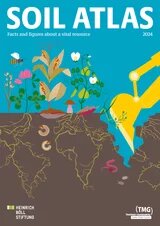
While desertification is a problem most commonly associated with Africa or Asia, it is not limited to these regions. Intensive agriculture and the climate crisis have also led to severe soil degradation and desertification in Europe. And not just in southern Europe: even countries with temperate and humid climates, such as Hungary and Bulgaria, are affected.

Desertification occurs mainly in regions marked by persistent water scarcity. Known as drylands, these regions cover more than 40 percent of the world’s land surface. Desertification threatens 24–29 percent of the global land area, impacting about 500 million people in 2015 according to the Intergovernmental Panel on Climate Change. This threat has intensified in recent decades, mainly due to climate change and human activity. Urban areas have expanded by approximately 250 percent globally over the past 40 years, while the area of irrigated cropland has more than doubled over the past 40 to 50 years. Among the most at-risk areas for desertification are the Sahel, the drylands of East Africa and Central Asia, the Indo-Gangetic Plain, and the North China Plain.
Desertification is a severe form of land degradation that predominantly occurs in arid, semi-arid, and sub-humid regions in the world. This process is primarily driven by human activities such as deforestation, livestock overgrazing, and unsustainable agricultural practices that lead to vegetation loss and soil degradation. Without the protective cover of plants, the soil is increasingly susceptible to both wind and water erosion, processes that strip away the nutrient-rich topsoil that is essential for plant growth. As this topsoil is eroded, the land gradually loses its productivity, eventually transforming once fertile land into barren, desert-like landscapes where little to no vegetation can survive. Climate change intensifies the problem by disrupting weather patterns, particularly by altering rainfall distributions and increasing the frequency and severity of droughts.
The effects of desertification are significant. It drastically lowers the productivity of farmland and limits its capacity to sustain populations and livelihoods. Scientists have found that agricultural productivity has fallen on around 23 percent of the world’s farmland due to land degradation.
Soils are also drying out in the European Union (EU). Thirteen EU Member States – not just in the South but also in Central and Eastern Europe – are affected by desertification. Across the EU, around 23 percent of the territory is moderately sensitive to desertification, with eight percent highly susceptible. Hungary, Bulgaria, Spain, and Italy are among the countries most affected. Land degradation in the EU is caused largely by intensive agriculture, which degrades soils through erosion, salinisation, and compaction. Overexploitation of water resources, depletion of the groundwater table, and reduction of water quality due to excessive fertiliser use are other factors that contribute to desertification. The increasing risk of heatwaves and wildfires also play a role. Copernicus, the EU’s Earth Observation Programme, recorded nearly four times as many wildfires during the first half of 2022 compared to the average of the previous 15 years. The risk of desertification is expected to worsen due to increased intensity and frequency of extreme climatic events.
Intensive agriculture is one of the key drivers of desertification. In Spain, for example, more and more water, much of it extracted from aquifers, is being used to grow fruit and vegetables for the European market. And the industry increasingly relies on groundwater. Between 2010 and 2016, groundwater consumption for the irrigation of highly profitable products, such as strawberries, lettuce, or broccoli, increased more than fivefold – from four to 22 percent. This overuse of water resources, coupled with water table decline and water quality deterioration due to excessive fertiliser use, is driving desertification.
Highly intensive berry farming in Portugal’s Alentejo region has led to significant soil destruction and erosion. To make way for large-scale greenhouses, multinational companies levelled the ground, drained the soil, and covered it with plastic, which severely damages the soil structure. The soil under the greenhouses becomes so degraded that restoring it becomes nearly impossible. Water scarcity exacerbates the situation, as parts of Portugal are facing its driest weather conditions in the past 1,200 years due to the expansion of the Azores High, a high-pressure system over the North Atlantic. Climate change has intensified this expansion, causing more frequent heatwaves and prolonged droughts. Experts warn that large swathes of the country are at risk of desertification by the end of this century.
The climate crisis and desertification are interrelated. Desertification is not only accelerated by the climate crisis; it also contributes to CO₂ emissions. As soils degrade, they lose organic matter, resulting in higher carbon emissions and lower capacities to absorb carbon.
Depending on its composition, healthy soil can store up to 3.75 million litres of water per hectare. However, desertification significantly impairs this capacity: for every gram of organic matter lost, the capacity of soil to retain water diminishes by 10 millimetres, according to several studies. This exacerbates the risk of flooding and leads to further water shortages. In response to the growing threat of desertification, the United Nations adopted the goal of so-called Land Degradation Neutrality. Similar to carbon offsetting, this approach stipulates that any unavoidable land degradation must be compensated for by restoring soil and ecosystem services in another location. However, the EU currently lacks a concrete strategy for achieving Land Degradation Neutrality by 2030.
In a recent report, the European Court of Auditors points out that progress towards this goal is inadequate. An important step would be an EU-wide agreement on common methods for assessing desertification. Understanding where desertification is likely to take place would help combat soil degradation before it becomes irreversible.

